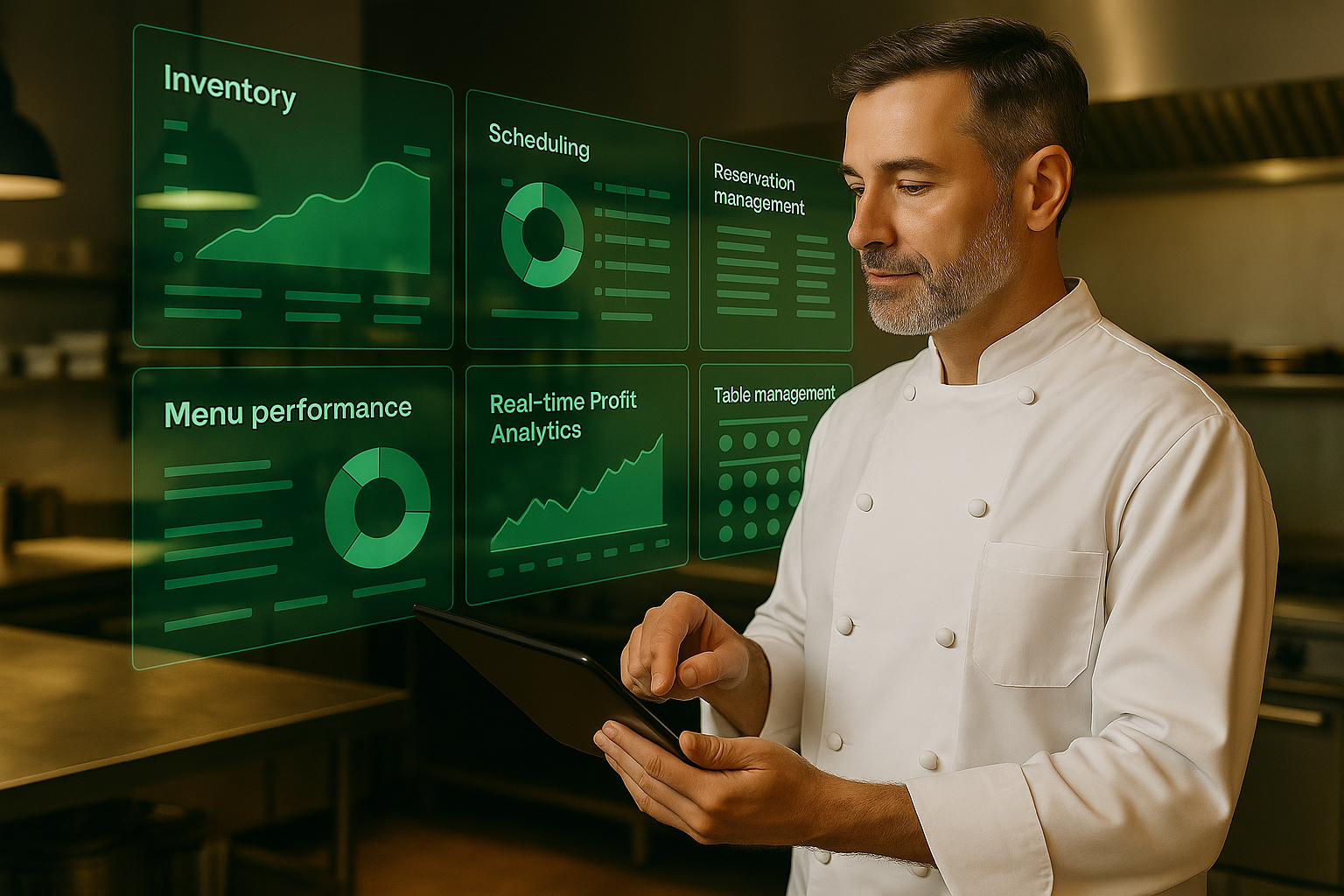Did you know that 60% of restaurants fail within their first year and 80% close within five years? Pretty sobering, right? While exceptional food and service are crucial, We've found that effective restaurant management plays an even bigger role in long-term success.
Let me tell you that restaurant inventory management, AI-powered systems, and restaurant management software are completely reshaping how successful restaurants operate. By embracing data-driven decision-making and integrated platforms like Eat App’s restaurant management system, you can boost profits dramatically and future-proof your operations.
The following blueprint outlines the proven steps to master restaurant management in 2025 and future-proof your success.

.png?width=670&height=354&name=Group%20495%20(1).png)
Audit your restaurant’s operations first
Before jumping into new strategies, I’ve seen smart restaurant owners audit their current operations first. Why? Because a comprehensive audit reveals those hidden inefficiencies that are silently eating away at your profits.
Where are workflow inefficiencies costing you?
Here’s something that shocked me: Workflow inefficiencies cost restaurants 15–20% of annual revenue. That’s money walking right out your door! To uncover these profit-killers:
- Document every process across all shifts
- Focus on kitchen, front-of-house, cleaning routines, and communication
- Interview staff to identify bottlenecks (they often see problems managers miss!)
- Conduct time-motion studies to benchmark tasks
- Optimize your floor plan to eliminate unnecessary traffic
- Analyze peak hours for operational breakdowns
Pro tip
I’ve seen restaurants boost efficiency by 10–15% immediately just by re-organizing stations or repositioning equipment. Sometimes the simplest changes make the biggest difference!
Is your tech stack helping or hurting you?
Let’s be honest that collection of systems you’ve cobbled together might be creating more problems than solutions. I recommend evaluating your current technology:
- POS system
- Inventory management software
- Table management and reservation tools
- Kitchen display systems
- Employee scheduling apps
- Accounting platforms
I’ve worked with restaurants that transformed their operations by integrating with robust platforms like Eat App’s restaurant management system that unify POS, reservations and more.
Ask yourself these key questions:
- Are your systems fully integrated, or are they working against each other?
- How up-to-date is your hardware/software? (Being two versions behind can cost you!)
- Which manual processes could be automated to free up your team?
- Is your team maximizing all the tool capabilities you’re already paying for?
Quick insight
I consistently see that restaurants using integrated systems report 12–15% higher profit margins compared to those with fragmented tech stacks.That difference alone can determine whether you thrive or barely survive.
Still using manual systems? I get it, change is hard. But could you consider moving from pen and paper to reservation software to streamline operations immediately? I’ve never met an owner who regretted this transition!
Implement smart inventory and cost controls
In my experience working with restaurants of all sizes, inventory management remains both a top challenge and opportunity for boosting profitability.
AI-driven inventory tracking: Why it matters?
Remember the days of late-night inventory counts and manually placing orders? Thank goodness those are ending!
Modern AI systems deliver:
- Real-time inventory monitoring (no more running out of key ingredients during Saturday rush!)
- Automatic reordering based on usage patterns
- Expiration alerts to reduce spoilage
- POS integration for live inventory updates
Predictive ordering: Your secret weapon
This is where things get exciting! AI analyzes:
- Historical sales (including those odd patterns you might miss)
- Seasonal demand fluctuations
- Perishability and stock turnover rates
Automate labor and scheduling to boost efficiency
Let’s talk about labor, often accounting for 30–35% of restaurant revenue. Optimize it, and you boost profits significantly.
The power of AI scheduling tools
I remember the days of scheduling staff with paper calendars and endless text messages. Never again! AI-driven scheduling solutions help you:
- Align staffing with sales forecasts (no more overstaffing slow nights)
- Honor employee availability and preferences (happy staff = happy customers)
- Prevent overtime with predictive labor management
- Save managers 6+ hours per week (what would you do with that extra time?)
Balancing costs and customer service
Finding that sweet spot between controlling costs and maintaining service isn’t just art it’s science. Optimal labor costs typically run:
- 25–35% of revenue, depending on restaurant type
- Fine dining skews higher; quick-service stays leaner
I’ve consistently found that restaurants using AI scheduling cut labor costs by up to 15% while enhancing employee satisfaction. It’s that rare win-win we’re all searching for in business.
Data-driven menu engineering and pricing strategies
Want to know one of my favorite restaurant profit levers? Menu optimization directly boosts profitability when done right.
Calculate item-level profitability
For years, I worked with restaurants that priced menus based on gut feeling. Big mistake! Let’s understand the math:
- Contribution Margin = Selling Price – Cost of Ingredients
- Menu Item Profitability = (Sales × Menu Price) – (Sales × Cost)
Through careful analysis, I’ve found the ideal food cost sits around 28–32% of menu prices for most concepts.
Use menu engineering to classify dishes:
| Category | Action |
| Stars (High Profit, High Sales) | Promote heavily (these are your moneymakers!) |
| Puzzles (High Profit, Low Sales) | Boost visibility (hidden gems needing attention) |
| Workhorses (Low Profit, High Sales) | Adjust pricing (small increases add up) |
| Dogs (Low Profit, Low Sales) | Rework or remove (they’re dragging you down) |
I’ve seen strategic positioning of “Star” items increase selection by up to 35%. That’s real money flowing directly to your bottom line!
Leverage AI restaurant software to analyze your menu performance and make data-driven decisions about pricing and placement. I wish I’d had these tools when I started in this industry. The insights are game-changing.
Experiment with dynamic pricing
Ready for some advanced strategies? I’ve helped restaurants implement dynamic pricing with impressive results:
- Time-based discounts during off-peak hours (fill those empty tables!)
- Delivery price adjustments (most customers expect a 24% average markup)
Integrate financial tools for real-time profitability insights
In my years working with restaurants, I’ve noticed one clear pattern: strong financial visibility separates thriving restaurants from struggling ones.
Best accounting software for restaurants
After testing dozens of platforms, these rise to the top:
- Restaurant365 (an all-in-one financial suite that I love for larger operations)
- QuickBooks Online (widely adopted and user-friendly for smaller teams)
- Xero (my go-to recommendation for growing brands)
When evaluating options, I prioritize these features:
- POS integration (manual data entry is so 2010!)
- Payroll and inventory syncing (everything connected)
- Real-time reporting and dashboards (no more waiting for month-end surprises)
For seamless operations, consider how these tools can integrate with your restaurant management system for unified data flows. I’ve seen this integration cut accounting hours by 70%!
Streamline your tech systems for unified management
Disconnected systems waste time and money. I learned this lesson the expensive way!
Connect your core systems
Integration delivers benefits I’ve seen transform restaurant operations:
- No duplicate entries (enter data once, use it everywhere)
- Synchronized data across POS, inventory, and payroll
- Unified reporting across locations (crucial for multi-unit brands)
Platforms like Eat App’s integrated technology ecosystems streamline restaurant management effortlessly.
Restaurant operators say: 75% believe tech integration gives a competitive edge. After seeing the results firsthand, I’d put that number closer to 100%!
Real-time reporting and smart alerts
The benefits I’ve seen restaurants gain:
- Instant inventory alerts (never run out of signature items again)
- Labor cost monitoring (catch problems before payroll)
- Missed sales target warnings (course-correct mid-shift)
- Food cost anomaly detection (catch theft or waste immediately)
Mobile access ensures managers stay informed anytime, anywhere something I wish we’d had in the “old days” of restaurant management!
The future of restaurant management is integrated and data-driven
Based on trends I’m tracking, the restaurants that will thrive in 2025 will:
- Embrace AI-powered tools and predictive analytics
- Base decisions on real-time data (not gut instinct)
- Connect systems for seamless operations
Quick Fact
We've noticed that managers using integrated platforms spend 70% less time on admin work freeing them to focus on guests and growth. Isn’t that why most of us got into this business in the first place?
The initial investment pays off, typically delivering ROI within 6–12 months. We’ve guided dozens of restaurants through this transition, and while change is never easy, the results speak for themselves.
Ready to transform your restaurant operations with AI-powered technology?
We have seen firsthand how these changes can revolutionize a restaurant’s performance. Explore Eat App’s complete restaurant management system here and future-proof your success in 2025 and beyond.














.webp?width=200&name=undefined-Nov-13-2025-10-01-55-9751-AM%20(1).webp)

-1.png?width=1812&height=1072&name=TripAdvisor%20%26%20More%20Bookings%20(1)-1.png)
-2.png?width=1812&height=1072&name=Google%20Bookings%20(1)-2.png)

.png?width=200&name=AI%20Tools%20for%20Restaaurants%20(4).png)
-1.png?width=200&name=TripAdvisor%20%26%20More%20Bookings%20(1)-1.png)
-2.png?width=200&name=Google%20Bookings%20(1)-2.png)
-1.png?width=200&name=Instagram%20Bookings%20(1)-1.png)
-1-png.webp?width=200&name=Facebook%20Integration%20Rectangle%20(1)-1-png.webp)







.webp?width=200&name=download%20(1).webp)
%20(1)-2.webp?width=200&name=Eat%20(34)%20(1)-2.webp)
%20(1)-2.webp?width=200&name=Eat%20(18)%20(1)-2.webp)











.webp?width=144&height=72&name=Eat%20App%20Logo%20(3).webp)